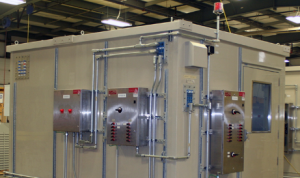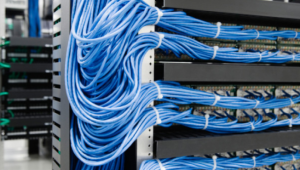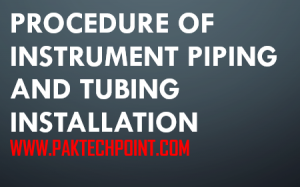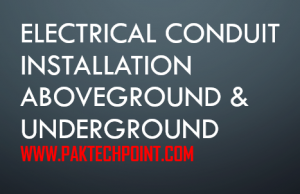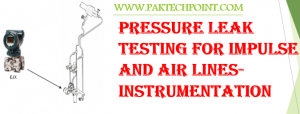GENERAL REQUIREMENTS
- Study and prepare all installation requirements, and related references such as approved for construction drawings, layout, P&ID, hook-up drawings, Technical Scope of Work, Work Permit requirements and work procedures.
- All permanent materials (including fabricated and pre-fabricated supports) and consumables to be installed shall be prepared and checked prior to installation works.
- Ensure that working areas are ready for installation to include availability of scaffolding if needed, supports and access to avoid delays of the activities.
- Ensure that the tapping point and tubing routes are well coordinated with piping, mechanical and related construction group to avoid conflicts that would cause delay in the approved schedule. Study tubing routes and possible locations of supports for fabrication if needed.
- Ensure that manpower, equipment, tools and other logistics are ready and prepared for installation.
PROCEDURE OF INSTRUMENT PIPING AND TUBING INSTALLATION
- Survey and study the designated location of field instrument in accordance to the EPC latest issued approved for construction drawings this to include the hook-up drawings, P&ID and layouts. Should there be discrepancies or obstructions found in the construction drawings, technical queries should be raised to EPC for further site instructions.
- Routes of instrument air branch supply lines shall be taken from the top of the header or air manifold that is accessible for maintenance.
- Upon identification of final specific routes of air piping, fabricate and install corresponding supports and brackets for instrument pipes and tubing as per Saudi Aramco Standard and EPC approved for construction drawing.
- Ensure that installed pipes, tubes and its fittings are damage free. Good handling practice shall be adhered to prevent scratches on pipe and tubing. The following points shall be followed.
a) Pipe or tubing shall not be dragged out by a tubing rack and shall be carefully lifted by at least two people.
b) Pipe and tubing shall not be dragged across concrete, asphalt, gravel or any other surface which could scratch it. c) Pipe or tubing shall not be stored/laid down on the ground at site where personnel can stand on it. Sufficient measures shall be taken to protect and preserve tubing at site (i.e. segregated storage, wooden blocks, etc.) - All tubing shall be covered with fire blanket when grinding, drilling, and welding works is being carried out in the area.
- Tubing shall be installed in a manner that allows for calibration of instrument and removal of adjacent instruments, equipment and tubing. All piping and tubing shall not be pocketed.
- All tubing shall be installed in a neat manner with no signs of crimping, flattening, or bends with radius too small. Tubing shall not be marked or scored. Slope angle of tubing shall be minimum 1 :12.
- For gas and vapor service, pressure transmitters shall be mounted above and as close to pressure taps as possible while still maintaining accessibility. Impulse lines shall slope continuously downward from transmitter to root valve such that they are self-draining (minimum one inch per foot).
- For liquid or condensing service, pressure transmitters shall be mounted below the pressure taps. Impulse lines shall slope continuously upward from transmitter to root valve such that they are self-venting (minimum one inch per foot).
- Tubing must have a minimum length of straight run adjacent to bend to correct installation of fittings.
- The length of unsupported tubing to its final location for single tubes shall not exceed 0.5 meters. Where signal tubing run over 6 meters, 150mm diameter loop shall be provided. For meter in flow control loop, any piping and impulse tubing shall not exceed 6 meters.
- Tubing shall be assembled with the specified compression fittings in accordance with the manufacturer’s instructions. The proper tools recommended by the manufacturer, shall be use to assure adequate engagement and tightness. Tube union can be used where approved by EPC.
- Tubing shall be blown through the clean dry air after installation and immediately prior to connection.
- Open end of the installed tubing shall be capped or taped to prevent entry of foreign matter.
- Manufacturer’s instructions shall be adhered at all times in installing compression fittings.
- Tube fittings installed in individual or parallel tube runs shall be staggered and raised to allow tube removal or reinstallation without damaging the individual tube or adjacent tubes.
- Proper sealant should be used for thread connection. (Special proper sealant shall be used for the connection more than 150°C process line).
